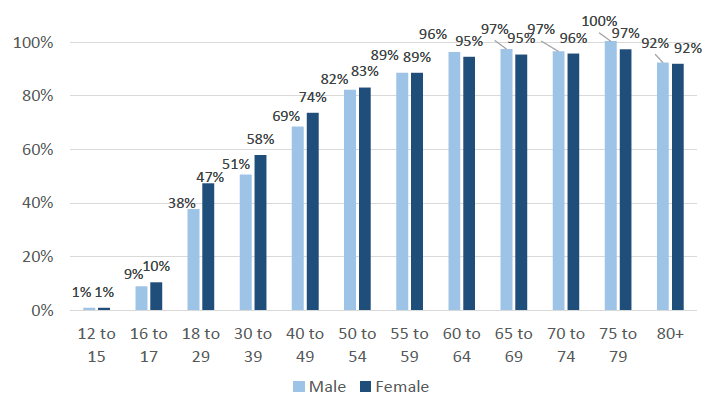Coronavirus (COVID-19): state of the epidemic - 28 January 2022
This report brings together the different sources of evidence and data about the Covid epidemic to summarise the current situation, why we are at that place, and what is likely to happen next.
This document is part of a collection
Resilience: Vaccinations, Antibody Estimates and Variants of Concern
Vaccinations
As of 26 January 2022 over 4.4 million people (91.9% of those aged over 12) had received their first dose and over 4.1 million people (86.0% of those aged over 12) had received their second dose. There remains a low level of deaths amongst vaccinated individuals[53].
A booster dose or a third dose of the vaccine is now available in Scotland, in line with JCVI advice including all adults aged over 16 for whom it has been at least 12 weeks since their second dose[54]. Over 3.2 million people (68.3% of those over 12 years of age) have received their dose 3 or booster vaccine by 26 January 2022[55].
Booster vaccine uptake is at least 92% amongst both males and females aged 60 or over, and around 89% for those aged 55 to 59. However, there is a difference between male and female vaccine uptake among those aged between 18 and 49 with females showing a higher uptake compared to males (Figure 12).

Antibodies Estimates
The ONS Covid-19 Infection Survey estimated that in the week beginning 3 January 2022, 98.2% (95% credible interval: 97.7% to 98.6%) of the adult population (aged 16+) living in private residential households in Scotland would have tested positive for antibodies against SARS-CoV-2 at the standard threshold, as a result of having the infection in the past or being vaccinated. This compares to:
- 98.0% in England (95% credible interval: 97.6% to 98.3%),
- 97.4% in Wales (95% credible interval: 96.7% to 98.0%),
98.4% in Northern Ireland (95% credible interval: 97.4% to 98.9%)[56].
The percentage of adults (aged 16+) testing positive for antibodies at the standard antibody threshold ranged from 97.6% (95% credible interval: 95.7% to 98.7%) in those aged 80 and over to 99.2% (95% credible interval: 98.7% to 99.5%) in those aged 65 to 69. The percentage of children testing positive for antibodies at the standard antibody threshold is estimated to be 91.7% (95% credible interval: 84.4% to 95.9%) for those aged 12 to 15 years and 60.1% (95% credible interval: 42.9% to 76.9%) for those aged 8 to 11 years in Scotland in the week beginning 3 January 2022[57].
Variants of Concern: Omicron Variant
The latest Omicron risk assessment carried out by the UK Health Security Agency (UKHSA), established with high confidence from analysis of UK data that Omicron is showing increased growth advantage compared to Delta, the previously dominant variant. There is also high confidence that Omicron displays a substantial immune evasion properties, including both natural and vaccine derived immunity. However, Omicron infections have a reduced relative risk of hospitalisation (high confidence)[58].
The UKHSA reported that vaccine effectiveness against symptomatic disease with the Omicron variant is lower compared to the Delta variant, and that it wanes rapidly. For two doses of AstraZeneca, effectiveness against symptomatic disease dropped from between 45 and 50% to almost no effect against Omicron from 20 weeks after the second dose. For two doses of Pfizer or Moderna effectiveness against symptomatic disease dropped from around 65 to 70% down to around 10% by 20 weeks after the second dose. Between two to four weeks after a booster dose, vaccine effectiveness against symptomatic infection ranged from around 65 to 75%, dropping to 55 to 65% after between five and nine weeks, and to 45 to 50% after 10 or more weeks after the booster[59] [60].
However, vaccine effectiveness against hospitalisation is high, preliminarily estimated at 92% (89 to 94%) for Omicron after three doses of vaccine, dropping to 83% after ten or more weeks after a booster dose[61] [62]. More data is needed to estimate the duration of vaccine effectiveness against hospitalisation over time. Vaccine effectiveness against mortality with the Omicron variant is expected to be similar or higher than its effectiveness against hospitalisation.
There is evidence that there is reduced overall risk of hospitalisation for Omicron compared to Delta[63] [64], with the most recent estimate of the risk of presentation to emergency care or hospital admission with Omicron was approximately half of that for Delta[65].
Omicron sequences can be separated into 2 groups, BA.1 with the original Omicron mutations and a small outlying group, BA.2 with some shared mutations and some differences compared to BA.1. BA.2 sequences do not have the deletion at S:69/70 which gives the SGTF result[66]. The Omicron variant sub-lineage known as BA.2 has been designated a variant under investigation (VUI-22JAN-01) by the UK Health Security Agency (UKHSA). The original Omicron lineage, BA.1, is dominant in the UK and the proportion of BA.2 cases is currently low. However, there are increasing numbers of BA.2 sequences identified in the UK and internationally. It is unknown whether BA.2 has different properties to BA.1[67].
Contact
There is a problem
Thanks for your feedback